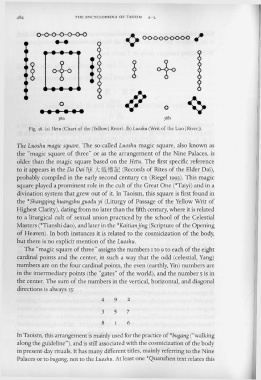Page 524 - The Encyclopedia of Taoism v1_A-L
P. 524
484 THE ENCYCLOPEDIA OF TAOISM A-L
0-0-0-0-0-o-o <:- 0<>-00<><><>0<> .-
---
+ i g +
Q
0 <>
••• ••• 0
38a 38b
Fig. 38. (a) Hetu (Chart of the [Yellow] River). (b) Luoshu (Writ of the Luo [River]).
The Luoshu magic square. The so-called Luoshu magic square, also known as
the "magic square of three" or as the arrangement of the Nine Palaces, is
older than the magic square based on the Hetu. The first specific reference
to it appears in the Da Dai liji *~t~ ~c (Records of Rites of the Elder Dai),
probably compiled in the early second century CE (Riegel 1993). This magic
square played a prominent role in the cult of the Great One (*Taiyi) and in a
divination system that grew out of it. In Taoism, this square is first found in
the *Shangqing huangshu guodu yi (Liturgy of Passage of the Yellow Writ of
Highest Clarity), dating from no later than the fifth century, where it is related
to a liturgical cult of sexual union practiced by the school of the Celestial
Masters (*Tianshi dao), and later in the *Kaitian jing (Scripture of the Opening
of Heaven). In both instances it is related to the cosrnicization of the body,
but there is no explicit mention of the Luoshu.
The "magic square of three" assigns the numbers I to 9 to each of the eight
cardinal points and the center, in such a way that the odd (celestial, Yang)
numbers are on the four cardinal points, the even (earthly, Yin) numbers are
in the intermediary points (the "gates" of the world), and the number 5 is in
the center. The sum of the numbers in the vertical, horizontal, and diagonal
directions is always IS:
492
357
8 I 6
In Taoism, this arrangement is mainly used for the practice of *bugang ("walking
along the guideline"), and is still associated with the cosrnicization of the body
in present-day rituals. It has many different titles, mainly referring to the Nine
Palaces or to bugang, not to the Luoshu. At least one *Quanzhen text relates this

